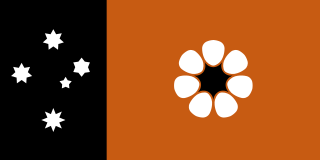
The Northern Territory is an Australian territory in the central and central northern regions of Australia. The Northern Territory shares its borders with Western Australia to the west, South Australia to the south, and Queensland to the east. To the north, the territory looks out to the Timor Sea, the Arafura Sea and the Gulf of Carpentaria, including Western New Guinea and other islands of the Indonesian archipelago.

Groote Eylandt is the largest island in the Gulf of Carpentaria and the fourth largest island in Australia. It was named by the explorer Abel Tasman in 1644 and is Dutch for "Large Island" in archaic spelling. The modern Dutch spelling is Groot Eiland.

Arnhem Land is a historical region of the Northern Territory of Australia, with the term still in use. It is located in the north-eastern corner of the territory and is around 500 km (310 mi) from the territory capital, Darwin. In 1623, Dutch East India Company captain Willem Joosten van Colster sailed into the Gulf of Carpentaria and Cape Arnhem is named after his ship, the Arnhem, which itself was named after the city of Arnhem in the Netherlands.
Maningrida, also known as Manayingkarírra and Manawukan, is an Aboriginal community in the heart of the Arnhem Land region of Australia's Northern Territory. Maningrida is 500 km (311 mi) east of Darwin, and 300 km (186 mi) north east of Jabiru. It is on the North Central Arnhem Land coast of the Arafura Sea, on the estuary of the Liverpool River.
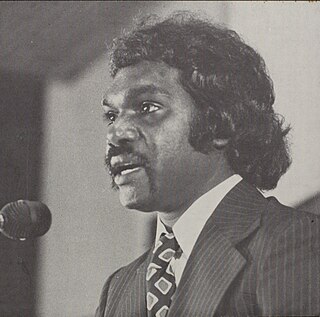
Galarrwuy Yunupingu, also known as James Galarrwuy Yunupingu and Dr Yunupingu, was an Indigenous leader in the Australian community, and certainly in his homelands. He was involved in Indigenous land rights throughout his career. He was a Yolngu man of the Gumatj clan, from Arnhem Land in the Northern Territory. He was the 1978 Australian of the Year.

The Aboriginal Land Rights Act 1976 (ALRA) is Australian federal government legislation that provides the basis upon which Aboriginal Australian people in the Northern Territory can claim rights to land based on traditional occupation. It was the first law by any Australian government that legally recognised the Aboriginal system of land ownership, and legislated the concept of inalienable freehold title, as such was a fundamental piece of social reform. Its long title is An Act providing for the granting of Traditional Aboriginal Land in the Northern Territory for the benefit of Aboriginals, and for other purposes.

The Tiwi Islands are part of the Northern Territory, Australia, 80 km (50 mi) to the north of Darwin adjoining the Timor Sea. They comprise Melville Island, Bathurst Island, and nine smaller uninhabited islands, with a combined area of 8,320 square kilometres (3,212 sq mi).
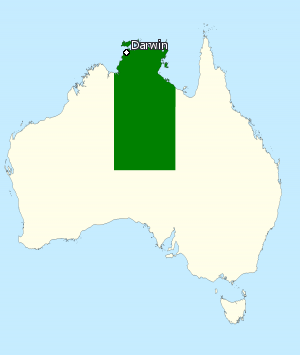
The Division of Lingiari is an Australian electoral division in the Northern Territory that covers the entirety of the territory outside of the Division of Solomon, which covers Darwin and surrounding areas. The division also includes the territories of Christmas Island and the Cocos (Keeling) Islands.

Marion Rose Scrymgour is an Australian politician and the current MP for Lingiari. She was a member of the Northern Territory Legislative Assembly from 2001 to 2012, representing the electorate of Arafura. She was the Labor Party Deputy Chief Minister of the Northern Territory from November 2007 until February 2009, and was the highest-ranked Indigenous Australian woman in government in Australia's history. She was also the first Indigenous woman to be elected to the Northern Territory legislature.
The Central Land Council (CLC) is a land council that represents the Aboriginal peoples of the southern half of the Northern Territory of Australia (NT), predominantly with regard to land issues. it is one of four land councils in the Northern Territory, and covers the Central Australia region. The head office is located in Alice Springs.

Batchelor Institute of Indigenous Tertiary Education provides training and further education, and higher education for Aboriginal Australians and Torres Strait Islanders. It is based in Kungarakany and Awarai country, in Batchelor, Northern Territory in Australia.

The Local Court of the Northern Territory is one of two levels of court in the Northern Territory of Australia. It has jurisdiction in civil disputes up to A$250,000, and in criminal cases in the trial of summary offences, and also deals with preliminary matters for indictable offences which are then heard by the Supreme Court of the Northern Territory. There are local courts held in Darwin, Northern Territory, Alice Springs, Katherine, Tennant Creek, and some "bush courts" in remote locations.
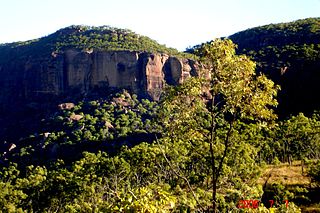
An Indigenous Protected Area (IPA) is a class of protected area used in Australia; each is formed by voluntary agreement with Indigenous Australians, and declared by Aboriginal Australians and Torres Strait Islander representative organisations. Each is formally recognised by the Australian Government as being part of its National Reserve System. The areas may comprise land and sea, and are managed by Indigenous groups for the conservation of biodiversity. Managing IPAs also helps to protect the cultural values of their country for future generations, and has benefits for Indigenous health, education, economic and social cohesion.
Raymattja Marika, also known as Gunutjpitt Gunuwanga, was a Yolngu leader, scholar, educator, translator, linguist and cultural advocate for Aboriginal Australians. She was a Director of Reconciliation Australia and a member of the Australian Institute of Aboriginal and Torres Strait Islander Studies. She was also a director of the Yothu Yindi Foundation and a participant in the 2020 Summit, which was held in April 2008. Marika advocated understanding and reconciliation between Indigenous Australian and Western cultures.
Land councils, also known as Aboriginal land councils, or land and sea councils, are Australian community organisations, generally organised by region, that are commonly formed to represent the Indigenous Australians who occupied their particular region before the arrival of European settlers. They have historically advocated for recognition of traditional land rights, and also for the rights of Indigenous people in other areas such as equal wages and adequate housing. Land councils are self-supporting, and not funded by state or federal taxes.
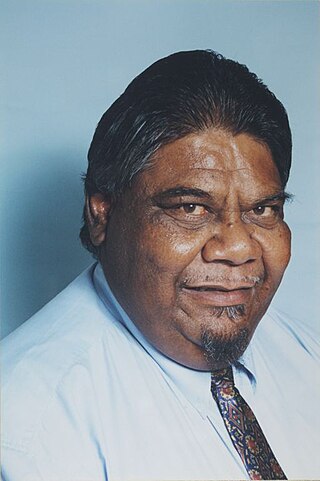
John Leonard Ah Kit was an Australian politician. He was the Labor member for Arnhem in the Northern Territory Legislative Assembly from 1995 to 2005.
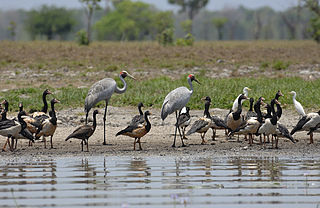
Blue Mud Bay is a large, shallow, partly enclosed bay on the eastern coast of Arnhem Land, in the Northern Territory of Australia, facing Groote Eylandt on the western side of the Gulf of Carpentaria. It lies 580 km (360 mi) east-south-east of Darwin in the Arnhem Coast bioregion. Its name was given to a landmark court ruling affirming that the Aboriginal traditional owners of much of the Northern Territory's coastline have exclusive rights over commercial and recreational fishing in tidal waters overlying their land.
Ngukurr, formerly Roper River Mission (1908−1968), is a remote Aboriginal community on the banks of the Roper River in southern Arnhem Land, Northern Territory.
Bäniyala is a tiny community of Aboriginal Australian people, known as a homeland, situated on Blue Mud Bay in the Gulf of Carpentaria in East Arnhem Land in the Northern Territory of Australia, located 210 kilometres (130 mi) from Nhulunbuy. It is home to about 150 Yolŋu people.












